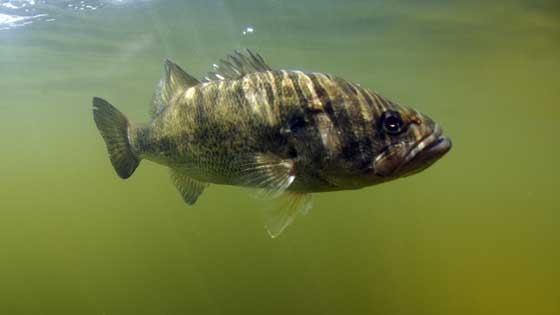Largemouth Bass Deep Water Fishing

Deep water fishing is mostly a winter, late fall or early spring form of fishing. When the water gets colder largemouth bass head for deeper water, leaving the rivers and streams alone during this time.
Best fishing methods
- Baitcasting or trolling works best when Largemouth Bass are found in deeper waters.
A fish finder is essential if you don’t know the water very well.
Fly fishing can work during this time of year but it’s not the most recommended type of fishing. If you’re going fly fishing, use wet flies.
In deep lakes bass inhabit the same structures as they do in shallow lakes, only the submerged formations are very deep.
Remember largemouth bass only go deep for 2 reasons
- If the overall water conditions and weather above is cold.
- Their food moves deeper also due to the cold.
Generally they don’t go deep in the summer.
A good rule of thumb is that largemouth bass can be found in the first 5 feet of water in the summer.
Best lures for deep water conditions
When trolling in deep water you might have over 100 yards of line between the rod and the lure. Tension between the rod and the lure is weak so holding the rod, rather than using a holder will provide greater sensitivity for subtle strikes.
- Use large reels, a heavy rod, lead-core line testing up to 30 lbs
- Large deep-diving crankbaits and lures resembling small rainbow trout.
After attending a fishing conference, we found out that southern bass anglers recommend using the Boy Howdy in silver with black back.
Move this lure through the water with steady reeling and the occasional twitch. Pause once in a while as it’s moved through the weeds. Notice the front and rear propeller heads. This technique works best in the southern United States lakes.
Ice Fishing – Want to know how to find the bass?
Bass Tip # 1
- Find the pan fish
The key to locating and catching largemouth bass through the ice is locating pan fish. These are small ‘pan sized’ fish, much like the common sunfish.
Pan fish get the attention of largemouth bass. Without the presence of pan fish, the probability of catching largemouth bass drops to nil.
Note: The term ‘pan fish’ is used for baitfish and also smaller fish used for camp frying in the pan.
Bass Tip # 2
- Find locations that have weeds. This is another requirement for catching largemouth bass.
Now just because the lake is covered by a sheet of ice doesn’t mean that the largemouth bass don’t enjoy the same cover as they do in summer.
- One of the types of weed that bass are attracted to is the cabbage weed. They stay green throughout much of the winter. Even in very low light. Bass like it because it provides good cover for many fish and offers up both oxygen and food.
If you want to be successful trolling for deep-water lunkers, be prepared for the expense. A depth finder is needed for finding structures at depths exceeding 80 feet, and the lures are often snagged on bottom obstacles at a cost of around $8.00 and more per lure.
Looking for fishing gear?
Stocking Programs
Stocking lakes and reservoirs with Largemouth Bass is pretty common these days. The largemouth bass has been introduced to countries around the world including many European countries.
East Asia bass fishing is very popular as is bass fishing off the coast of Africa. However, Florida bass fishing is one of the top spots due to the few places outside of South America that has the Largemouth Bass, the Florida Largemouth Bass and the Peacock Bass in the same area.
In the 1940s, southern California lakes were stocked with largemouth bass and in the 1950’s, they were stocked with the larger Florida sub species.
Not every lake was stocked with these fish. They were limited to deep lakes. This has resulted in these lakes growing many large fish. The largest largemouth, 22lb 4 ounces, was taken from Montgomery Lake in Georgia.



